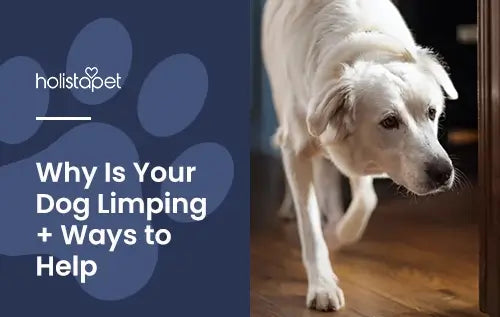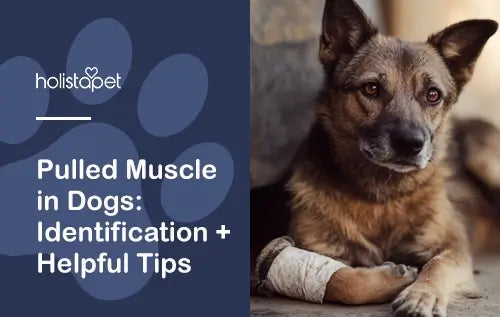Why is my dog limping, you ask? Your furry friend might be dealing with anything from a minor paw injury to a more serious issue like joint disease.
Finding the root cause, whether it's a case of sudden limping or gradual onset limping, is key to getting your pup back on all fours. Let's investigate what might be causing their limp.
Understanding Limping in Dogs
Limping could mean something's not quite right. This problem can stem from an injury, joint issue, or even a hidden health condition.
Unlike humans, dogs rely on all four legs for balance. Any issue with their limbs can throw them off their game.
Pay attention to visible signs and changes in their behavior. With early intervention, our canine friends can keep zooming without a care.
Common Reasons for Dog Limping

When dogs start limping, it's usually their way of saying, "Something hurts!" Common causes range from minor injuries like a cut paw to more serious problems like bone cancer.
Sometimes, dog owners notice gradual limping. Other times, it's a sudden onset that catches pet parents off guard. Understanding the underlying cause is the first step to finding the right solution.
Dog Limping Back Leg: Possible Causes
If your pup's back leg is giving them trouble, you need to quickly find the root. Here's what might be going on:
- Hip Dysplasia. This genetic issue messes with the hip joint, making every step a challenge.
- Ligament Tears. Too much zoomie action? A torn knee ligament might be the reason.
- Arthritis. Time isn't always kind to those joints, especially in older canines.
- Dislocated Joints. A hard knock or tumble can pop a joint out of place.
- Bone Fractures. Whether from a big leap or a clumsy fall, a broken bone screams for immediate attention.
Dog Limping Front Leg: What Could Be Wrong?
Front leg limping can throw your dog's whole vibe off. Here's what might be causing your furry friend's funky stride:
- Elbow Dysplasia. A developmental issue that makes the elbow joint cranky and stiff.
- Paw Injuries. Cuts, splinters, or even something sharp stuck in your dog's paw pads.
- Broken Bones A hard impact can lead to a break, making every step agony.
- Nerve Damage. When nerves take a hit, coordination and comfort go out the window.
- Popped Joints. One bad twist or fall and the joint could pop out of place.
Related Post: Dog Shoulder Injury, Causes, Symptoms, and Recovery
Injuries That May Cause Limping in Dogs
Sometimes, limping can hit like a curveball. And oftentimes, injuries are the prime suspects. Spotting the problem early helps avoid further damage and gets your pup back to their fun-loving self. Let's break down the common injuries that leave our four-legged friends limping.
Sprains and Strains
Sprains and strains can sideline even the bounciest pups. Here's what you need to know about these soft tissue injuries:
- Sprains. These involve stretched or torn ligaments, typically near the joints like ankles or wrists.
- Strains. These affect muscles or tendons and often occur during overzealous leaps or runs.
Both can cause a mild limp or serious hobble. Always keep your dog's activity in check to prevent further strain.
Related Post: Dog Sprained Leg Recovery Time and Comforting Tips
Fractures or Broken Bones
Fractures put a full stop to your pup's favorite activities. These injuries are often due to falls, car accidents, or rough play. Here's how to spot them:
- Visible Signs. Swelling, bruising, or an odd angle in the affected limb.
- Severe Limping. Your dog may avoid putting any weight on the affected leg.
- Behavioral Changes. Whimpering, licking the site, or showing unusual aggression when touched.
If you suspect a fracture, immediately get your pup to the vet's office. No waiting allowed!
Health Conditions That Can Cause Limping

Some limps have deeper roots in a dog's health status. Limps can creep up over time or strike suddenly. Knowing what might be behind the issue can help you tackle it head-on. Let's look at a few common conditions that could be causing your dog's lameness.
Arthritis and Joint Issues
Arthritis is like a buzzkill for your pup's joints. This condition causes stiffness and tenderness, making even simple movements a chore. It's especially common in older dogs.
Joint issues like ligament tears or dislocated joints can also leave your pup limping. These problems mess with joint function, causing discomfort in one or more legs.
Hip Dysplasia
This condition occurs when the hip joint doesn't fit snugly into its socket, causing friction and discomfort. It's often genetic and can affect both young pups and older dogs.
Affected dogs may have trouble standing, walking, or lying down. Early intervention, like weight management and joint supplements, can help your furry friend feel more at ease. For added support, you can check out HolistaPet's Dog Joint Support Soft Chews and CBD Dog Treats for Mobility.
Patellar Luxation
Patellar luxation sounds fancy, but it's basically a slipping kneecap. And yes, it's as uncomfortable as it sounds. This condition often affects smaller breeds.
You might notice your dog suddenly holding up a leg or limping after an activity. While mild cases may not need treatment, severe ones might require surgery.
My Dog Is Limping but Shows No Sign of Pain: What Should I Do?
Even without whining or yelping, something's likely bothering your pup. Minor issues could be the cause, or it might be the early stages of a deeper problem.
Inspect the affected limb closely for visible signs like swelling or cuts. If nothing seems obvious, seek veterinary advice to rule out hidden concerns. Better safe than sorry.
Finding the Root Cause of Your Dog's Limping

Figuring out why your dog is limping can feel like solving a mystery. The trick is to watch for obvious signs and pay attention to how your dog is moving. A physical examination at home can reveal clues. If the limp persists or worsens, it's time to let a vet take over.
What To Look for When Inspecting a Limping Dog
A quick home inspection can uncover why your dog is limping. Start by checking their entire limb and paw for any abnormalities. Here's what to look for:
- Swelling or Redness. Could signal a sprain, strain, or infection.
- Cuts or Abrasions. Small injuries could also cause a dog pain.
- Foreign Objects. Splinters, thorns, or even debris stuck between their toes or in their paw pad.
- Bruising or Discoloration. Can point to trauma or a more severe injury.
- Tenderness or Lumps. Gently press along the limb to check for sore spots or unusual bumps.
Related Post: Dog Paw Pad Injury: Causes, Symptoms, and Recovery
Will Dog Limping Resolve Itself?
Sometimes, a dog's limp might seem minor enough to fix itself but don't bet on it. While minor injuries may improve with rest, other issues can worsen without attention.
If the limping lasts more than a day or two, or if your dog's discomfort increases, don't wait. Seek veterinary care to make sure the problem doesn't spiral into something more serious. Quick action is always better than guessing.
How Long Is It Ok for My Dog To Limp?
A limp that lingers for more than 48 hours deserves a closer look. While minor injuries might heal on their own, prolonged limping could signal something more serious.
If your dog struggles to bear weight or the limp worsens, act fast. Don't wait weeks. Quick intervention can save your furry buddy from further discomfort and more complicated treatments.
How to Comfort a Limping Dog
When your dog is limping, they need some extra TLC. Here's how you can help:
- Rest and Restriction. Keep them calm and avoid high-energy activities.
- Apply a Cold Compress. Use it to reduce swelling in the affected area.
- Use a Warm Compress. Helps loosen tight muscles after the swelling goes down.
- Provide a Soft, Comfortable Resting Spot. A cushy bed works wonders for relaxation.
- Avoid Rough Handling. Be gentle when moving them, especially if they have joint pain.
- Massage the Affected Area. A light rub can relieve pain and improve circulation.
- Consider CBD or Natural Supplements. These can promote calm and provide soothing effects.
- Keep Your Dog Calm. Fun fact: CBD doesn't just help manage pain; it also helps keep your pup relaxed.
How Can CBD Provide Comfort to a Limping Dog?

CBD (cannabidiol) helps soothe discomfort while promoting a sense of calm. By supporting joint health and helping reduce puffiness, it offers natural relief without harsh side effects.
For quality CBD products for dogs, you can trust HolistaPet. We have tasty treats, oils, and capsules to help your pooch feel at ease. Always consult your vet before adding anything new to their routine.
How To Identify If Limping Is an Emergency
Some limps can wait, but others scream, "Emergency!" If your dog's limping comes with severe discomfort or swelling, or they refuse to bear weight, it's time for immediate action.
Check for broken bones, open wounds, or significant pain. Sudden-onset limping, especially in younger dogs, can also signal a serious issue. Don't wait—get your dog the help it needs.
When To See a Veterinarian for Limping
If your dog's limping doesn't improve after a day or two, or if it worsens, call the vet. Persistent limping, visible injuries, or significant pain all call for professional attention.
Your vet may recommend treatments like pain management, physical therapy, or even imaging tests to pinpoint the issue. Acting quickly can help prevent further injury and restore your dog to their usual playful self.
Preventing Limping in Dogs Through Proper Care
Prevention is the best cure for keeping your canine companion's legs strong and healthy. Regular exercise, weight management, and a balanced diet all play a role in maintaining joint health.
Adding gentle stretches to your dog's routine can help improve flexibility and strengthen muscles. Routine checkups with your vet guarantee early detection of joint issues or potential injuries. Trust us, little care goes a long way.
Exercises To Support Joint Health in Dogs
Keeping your dog active with low-impact exercises can promote healthy joints. Activities like swimming, slow walks, or controlled play sessions help strengthen muscles without overloading their joints.
If your dog has a history of limping, consider adding physical therapy exercises to their routine. Think gentle stretches or balance work. These movements can help improve joint function and keep your furry buddy feeling their best. As always, consult your vet before starting a new regimen.
Limping dogs deserve quick action and extra care. Spot the signs, seek help when needed, and keep those tails wagging with proper prevention and love!







![Probiotics For Dogs [Soft Chews] - HolistaPet](http://www.holistapet.com/cdn/shop/files/Probiotic-Infographic-1_472d7a29-e30c-435a-9638-1365d8c3a9f9.jpg?v=1725384841&width=104)



























Leave a comment
All comments are moderated before being published.
This site is protected by hCaptcha and the hCaptcha Privacy Policy and Terms of Service apply.